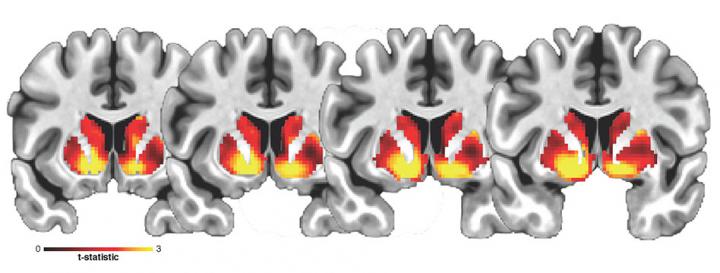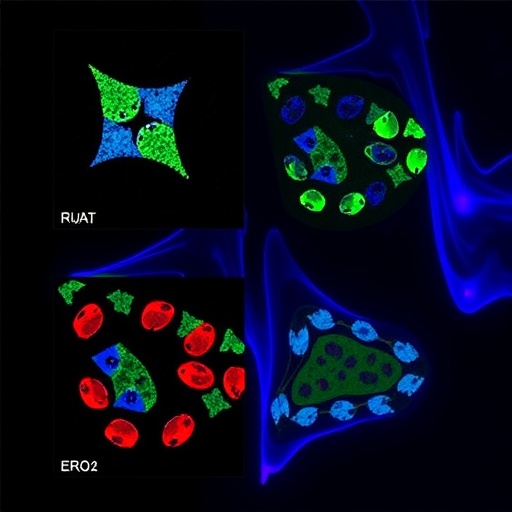Finding from ABCD Study elucidates neural mechanisms that may underlie early weight gain

Credit: Image modified from Rapuano, Laurent et al. PNAS 2020
Differences in the microstructure of the nucleus accumbens (NAcc), a region in the brain that plays an important role in processing food and other reward stimuli, predict increases in indicators of obesity in children, according to a study funded by the National Institute on Drug Abuse (NIDA) and nine other institutes, all part of the National Institutes of Health. The paper, published today in the journal Proceedings of the National Academy of Sciences, is based on data from the Adolescent Brain Cognitive Development (ABCD) Study. The ABCD Study will follow nearly 12,000 children through early adulthood to assess factors that influence individual brain development and other health outcomes.
Findings from this study provide the first evidence of microstructural brain differences that are linked to waist circumference and body mass index (BMI) in children. These microstructural differences in cell density could be indicative of inflammatory processes triggered by a diet rich in high fat foods.
“We know that childhood obesity is a key predictor of adult obesity and other poor health outcomes later in life,” said Nora D. Volkow, M.D., director of NIDA. “These results extend previous animal studies to reveal what may prove to be a vicious cycle in which diet-related inflammation in brain striatal regions promotes further unhealthy eating behaviors and weight gain.”
Evidence from past human imaging studies has demonstrated the relationship between the NAcc and unhealthy eating behavior in adults. In this study, the researchers leveraged new diffusion MRI imaging techniques to examine the cellular structure of areas that comprise the striatal reward pathway in the brain to investigate disproportionate weight gain in youth.
This study included data from 5,366 ABCD Study participants, ages 9- to 10-years-old at baseline, of whom 2,133 returned for a one-year follow-up visit. The mean waist circumference of the participants, used here as a measure of body fat, increased an average of 2.76 centimeters per participant from the baseline through the one-year follow-up. The researchers used a noninvasive MRI technique to show that an alleged marker of cellular density in the NAcc reflected differences in waist circumference at baseline and predicted increased waist circumference at one-year follow-up.
Because the ABCD Study is longitudinal, it will allow to assess if this association holds or changes over the course of adolescent development, and what factors may influence this trajectory.
Obesity in the United States affects approximately 35% of children and adolescents and is associated with negative health consequences, mentally and physically, as well as higher mortality rates. Children who are obese have more than a fivefold likelihood of becoming obese as adults. Predictive models of weight gain in youth, coupled with knowledge about factors that could impact this trajectory, would benefit public health and individual wellbeing.
###
The Adolescent Brain Cognitive Development Study and ABCD Study are registered trademarks and service marks, respectfully, of the U.S. Department of Health and Human Services (HHS).
Reference:
Rapuano, KM; Laurent, JS; Hagler, Jr. DJ; Hatton, SN; Thompson, WK; Jernigan, TL; Dale, AM; Casey, BJ; Watts, R. Nucleus accumbens cytoarchitecture predicts weight gain in children. PNAS. October 12, 2020.
https:/
About the National Institute on Drug Abuse (NIDA): NIDA is a component of the National Institutes of Health, U.S. Department of Health and Human Services. NIDA supports most of the world’s research on the health aspects of drug use and addiction. The Institute carries out a large variety of programs to inform policy, improve practice, and advance addiction science. For more information about NIDA and its programs, visit http://www.
About the National Institutes of Health (NIH): NIH, the nation’s medical research agency, includes 27 Institutes and Centers and is a component of the U.S. Department of Health and Human Services. NIH is the primary federal agency conducting and supporting basic, clinical, and translational medical research, and is investigating the causes, treatments, and cures for both common and rare diseases. For more information about NIH and its programs, visit http://www.
NIH…Turning Discovery Into Health®
Media Contact
NIDA Press Office
[email protected]
Original Source
https:/
Related Journal Article
http://dx.




